We learned early on that the best way to help my daughter Abby, who has cerebrocostomandibular syndrome, with her development is to adopt a “therapy lifestyle.” We don’t “check off” her therapy when it’s done each day. That could limit her therapy to just 10 or 15 minutes a day. Instead, we embed therapy into everyday life. Most of the time, she doesn’t even realize she’s working! And once she does and protests, we change it up.

Here are a few examples of how therapy can be incorporated into day-to-day activities:
1. Have your child push any doorbells and elevator buttons, as well as open any doors. Standing on tiptoes can strengthen and stretch the leg muscles and improve the arches of the feet, while opening doors can help with fine motor and arm strength. We will even intentionally put things on a higher shelf so she has to stand on her tiptoes to reach them.
2. Invest in a small exercise trampoline with a handle. This has seriously been a game-changer in our house! With this kind of trampoline, kids can practice high jumping, jumping on one foot, twisting while jumping, and even using Therabands while jumping! It’s a great little therapy tool that is a lot of fun.
3. At the grocery store, have your child call out the names of the fruits and vegetables he or she sees. Discuss the color, shape and size, and compare the sizes of different types of produce. It’s amazing how many opportunities to practice language skills you can find at the grocery store!
4. The bathtub is a great place to work on fine motor and language. Have your child pour water from one cup to another. We play a game where we see how long we can keep a cup of water going… the less Abby spills while she is pouring, the longer the water will last! Shaving cream, spray foam soap and bathtub paint are all great for practicing writing. With those materials, you can also talk about colors, discuss pictures that your child paints, etc.
5. Work on balance skills by walking on curbs (safely, of course!). It’s also fun to hop from one sidewalk block to the next. As Abby got older, we increased the amount of distance we wanted her to jump until she could jump over a sidewalk rectangle. This works well with tiles while you’re waiting at the doctor’s office, too!
6. Allow yourself permission to avoid the therapy check-off list if or when it’s not working for you. I’m sure you already do so much for your child already — just be intentional in the activities you do and look for ways to build in language, fine and gross motor activities. Therapy can be so much more effective when in the context of everyday activities, rather than as a separate component. Plus, that’s one less thing on your already huge “to do” list!
What are some other ways you have created a “therapy lifestyle” for your child?
The Mighty is asking the following: Create a list-style story of your choice in regards to disability, disease or illness. It can be lighthearted and funny or more serious — whatever inspires you. Be sure to include at least one intro paragraph for your list. If you’d like to participate, please send a blog post to community@themighty.com. Please include a photo for the piece, a photo of yourself and 1-2 sentence bio. Check out our Submit a Story page for more about our submission guidelines.
